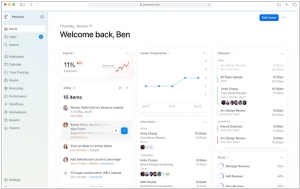Cacti vs Grafana
October 20, 2024 | Author: Michael Stromann
10★
Cacti is an open-source, web-based network monitoring and graphing tool designed as a front-end application for the open-source, industry-standard data logging tool RRDtool. Cacti allows a user to poll services at predetermined intervals and graph the resulting data.
See also:
Top 10 IT Monitoring software
Top 10 IT Monitoring software
Cacti and Grafana, though both excellent tools for monitoring and data visualization, are about as similar as a cactus and a spaceship. Cacti, as the name subtly implies, is rather focused on networks. It quietly hums in the background, using SNMP (which sounds a lot like a noise a particularly disgruntled robot might make) to gather data from network devices, happily creating graphs that make network administrators smile in a quiet, knowing way. It excels at historical data, showing you just how poorly your network performed last Tuesday and it's quite happy to keep doing that, all in its slightly old-fashioned, no-nonsense interface.
Grafana, on the other hand, is the sort of tool you’d expect to find on a spaceship's dashboard, complete with flashing lights and buttons that go *ping* at the most opportune moments. It doesn’t just stick to networks—oh no—it integrates with almost anything you throw at it: databases, cloud services, time-series databases like Prometheus (which sounds like something you’d find orbiting a distant star). Its strength lies in its ability to craft dashboards that are both beautiful and useful, like a well-designed space station. Grafana’s modern interface makes Cacti look like it was made by a committee of bureaucrats who’ve never seen a dashboard in their lives.
The real difference, though, lies in how much effort they demand of you. Cacti, like assembling a flat-pack cactus, requires a bit more hands-on work. You’ll need to configure it, twist a few knobs and probably consult a manual or two. Grafana, by contrast, makes dashboard creation as easy as ordering from a well-curated menu at Milliways. It’s customizable, intuitive and generally makes you look far more competent than you are—perfect for anyone hoping to make real-time data look like an art form rather than a chore. The choice, as always, depends on whether you're managing a network or a galaxy.
See also: Top 10 IT Monitoring software
Grafana, on the other hand, is the sort of tool you’d expect to find on a spaceship's dashboard, complete with flashing lights and buttons that go *ping* at the most opportune moments. It doesn’t just stick to networks—oh no—it integrates with almost anything you throw at it: databases, cloud services, time-series databases like Prometheus (which sounds like something you’d find orbiting a distant star). Its strength lies in its ability to craft dashboards that are both beautiful and useful, like a well-designed space station. Grafana’s modern interface makes Cacti look like it was made by a committee of bureaucrats who’ve never seen a dashboard in their lives.
The real difference, though, lies in how much effort they demand of you. Cacti, like assembling a flat-pack cactus, requires a bit more hands-on work. You’ll need to configure it, twist a few knobs and probably consult a manual or two. Grafana, by contrast, makes dashboard creation as easy as ordering from a well-curated menu at Milliways. It’s customizable, intuitive and generally makes you look far more competent than you are—perfect for anyone hoping to make real-time data look like an art form rather than a chore. The choice, as always, depends on whether you're managing a network or a galaxy.
See also: Top 10 IT Monitoring software





